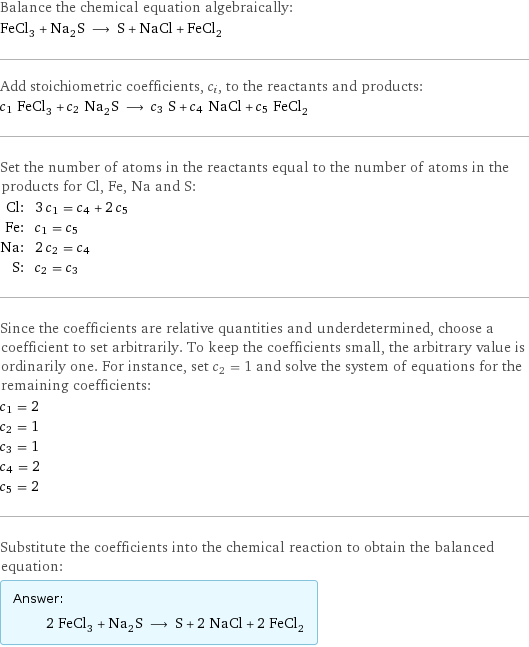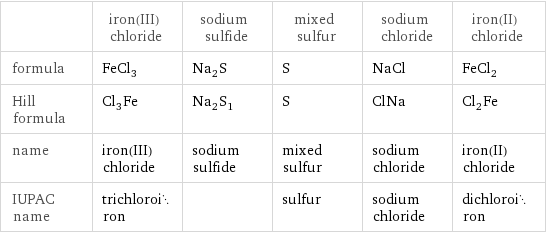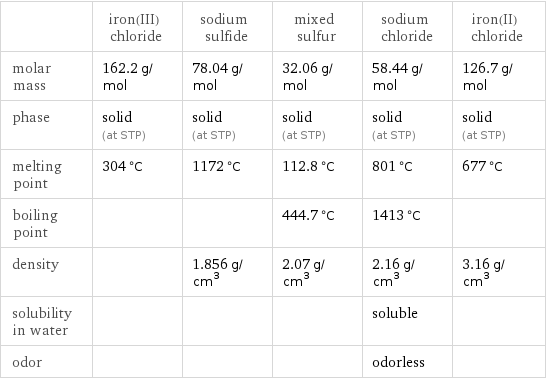Input interpretation

FeCl_3 iron(III) chloride + Na_2S sodium sulfide ⟶ S mixed sulfur + NaCl sodium chloride + FeCl_2 iron(II) chloride
Balanced equation

Balance the chemical equation algebraically: FeCl_3 + Na_2S ⟶ S + NaCl + FeCl_2 Add stoichiometric coefficients, c_i, to the reactants and products: c_1 FeCl_3 + c_2 Na_2S ⟶ c_3 S + c_4 NaCl + c_5 FeCl_2 Set the number of atoms in the reactants equal to the number of atoms in the products for Cl, Fe, Na and S: Cl: | 3 c_1 = c_4 + 2 c_5 Fe: | c_1 = c_5 Na: | 2 c_2 = c_4 S: | c_2 = c_3 Since the coefficients are relative quantities and underdetermined, choose a coefficient to set arbitrarily. To keep the coefficients small, the arbitrary value is ordinarily one. For instance, set c_2 = 1 and solve the system of equations for the remaining coefficients: c_1 = 2 c_2 = 1 c_3 = 1 c_4 = 2 c_5 = 2 Substitute the coefficients into the chemical reaction to obtain the balanced equation: Answer: | | 2 FeCl_3 + Na_2S ⟶ S + 2 NaCl + 2 FeCl_2
Structures

+ ⟶ + +
Names

iron(III) chloride + sodium sulfide ⟶ mixed sulfur + sodium chloride + iron(II) chloride
Equilibrium constant
![Construct the equilibrium constant, K, expression for: FeCl_3 + Na_2S ⟶ S + NaCl + FeCl_2 Plan: • Balance the chemical equation. • Determine the stoichiometric numbers. • Assemble the activity expression for each chemical species. • Use the activity expressions to build the equilibrium constant expression. Write the balanced chemical equation: 2 FeCl_3 + Na_2S ⟶ S + 2 NaCl + 2 FeCl_2 Assign stoichiometric numbers, ν_i, using the stoichiometric coefficients, c_i, from the balanced chemical equation in the following manner: ν_i = -c_i for reactants and ν_i = c_i for products: chemical species | c_i | ν_i FeCl_3 | 2 | -2 Na_2S | 1 | -1 S | 1 | 1 NaCl | 2 | 2 FeCl_2 | 2 | 2 Assemble the activity expressions accounting for the state of matter and ν_i: chemical species | c_i | ν_i | activity expression FeCl_3 | 2 | -2 | ([FeCl3])^(-2) Na_2S | 1 | -1 | ([Na2S])^(-1) S | 1 | 1 | [S] NaCl | 2 | 2 | ([NaCl])^2 FeCl_2 | 2 | 2 | ([FeCl2])^2 The equilibrium constant symbol in the concentration basis is: K_c Mulitply the activity expressions to arrive at the K_c expression: Answer: | | K_c = ([FeCl3])^(-2) ([Na2S])^(-1) [S] ([NaCl])^2 ([FeCl2])^2 = ([S] ([NaCl])^2 ([FeCl2])^2)/(([FeCl3])^2 [Na2S])](../image_source/54f26cedbd344eab333226f96cf0408f.png)
Construct the equilibrium constant, K, expression for: FeCl_3 + Na_2S ⟶ S + NaCl + FeCl_2 Plan: • Balance the chemical equation. • Determine the stoichiometric numbers. • Assemble the activity expression for each chemical species. • Use the activity expressions to build the equilibrium constant expression. Write the balanced chemical equation: 2 FeCl_3 + Na_2S ⟶ S + 2 NaCl + 2 FeCl_2 Assign stoichiometric numbers, ν_i, using the stoichiometric coefficients, c_i, from the balanced chemical equation in the following manner: ν_i = -c_i for reactants and ν_i = c_i for products: chemical species | c_i | ν_i FeCl_3 | 2 | -2 Na_2S | 1 | -1 S | 1 | 1 NaCl | 2 | 2 FeCl_2 | 2 | 2 Assemble the activity expressions accounting for the state of matter and ν_i: chemical species | c_i | ν_i | activity expression FeCl_3 | 2 | -2 | ([FeCl3])^(-2) Na_2S | 1 | -1 | ([Na2S])^(-1) S | 1 | 1 | [S] NaCl | 2 | 2 | ([NaCl])^2 FeCl_2 | 2 | 2 | ([FeCl2])^2 The equilibrium constant symbol in the concentration basis is: K_c Mulitply the activity expressions to arrive at the K_c expression: Answer: | | K_c = ([FeCl3])^(-2) ([Na2S])^(-1) [S] ([NaCl])^2 ([FeCl2])^2 = ([S] ([NaCl])^2 ([FeCl2])^2)/(([FeCl3])^2 [Na2S])
Rate of reaction
![Construct the rate of reaction expression for: FeCl_3 + Na_2S ⟶ S + NaCl + FeCl_2 Plan: • Balance the chemical equation. • Determine the stoichiometric numbers. • Assemble the rate term for each chemical species. • Write the rate of reaction expression. Write the balanced chemical equation: 2 FeCl_3 + Na_2S ⟶ S + 2 NaCl + 2 FeCl_2 Assign stoichiometric numbers, ν_i, using the stoichiometric coefficients, c_i, from the balanced chemical equation in the following manner: ν_i = -c_i for reactants and ν_i = c_i for products: chemical species | c_i | ν_i FeCl_3 | 2 | -2 Na_2S | 1 | -1 S | 1 | 1 NaCl | 2 | 2 FeCl_2 | 2 | 2 The rate term for each chemical species, B_i, is 1/ν_i(Δ[B_i])/(Δt) where [B_i] is the amount concentration and t is time: chemical species | c_i | ν_i | rate term FeCl_3 | 2 | -2 | -1/2 (Δ[FeCl3])/(Δt) Na_2S | 1 | -1 | -(Δ[Na2S])/(Δt) S | 1 | 1 | (Δ[S])/(Δt) NaCl | 2 | 2 | 1/2 (Δ[NaCl])/(Δt) FeCl_2 | 2 | 2 | 1/2 (Δ[FeCl2])/(Δt) (for infinitesimal rate of change, replace Δ with d) Set the rate terms equal to each other to arrive at the rate expression: Answer: | | rate = -1/2 (Δ[FeCl3])/(Δt) = -(Δ[Na2S])/(Δt) = (Δ[S])/(Δt) = 1/2 (Δ[NaCl])/(Δt) = 1/2 (Δ[FeCl2])/(Δt) (assuming constant volume and no accumulation of intermediates or side products)](../image_source/71c3525f511f189bbf3962ca99bc8223.png)
Construct the rate of reaction expression for: FeCl_3 + Na_2S ⟶ S + NaCl + FeCl_2 Plan: • Balance the chemical equation. • Determine the stoichiometric numbers. • Assemble the rate term for each chemical species. • Write the rate of reaction expression. Write the balanced chemical equation: 2 FeCl_3 + Na_2S ⟶ S + 2 NaCl + 2 FeCl_2 Assign stoichiometric numbers, ν_i, using the stoichiometric coefficients, c_i, from the balanced chemical equation in the following manner: ν_i = -c_i for reactants and ν_i = c_i for products: chemical species | c_i | ν_i FeCl_3 | 2 | -2 Na_2S | 1 | -1 S | 1 | 1 NaCl | 2 | 2 FeCl_2 | 2 | 2 The rate term for each chemical species, B_i, is 1/ν_i(Δ[B_i])/(Δt) where [B_i] is the amount concentration and t is time: chemical species | c_i | ν_i | rate term FeCl_3 | 2 | -2 | -1/2 (Δ[FeCl3])/(Δt) Na_2S | 1 | -1 | -(Δ[Na2S])/(Δt) S | 1 | 1 | (Δ[S])/(Δt) NaCl | 2 | 2 | 1/2 (Δ[NaCl])/(Δt) FeCl_2 | 2 | 2 | 1/2 (Δ[FeCl2])/(Δt) (for infinitesimal rate of change, replace Δ with d) Set the rate terms equal to each other to arrive at the rate expression: Answer: | | rate = -1/2 (Δ[FeCl3])/(Δt) = -(Δ[Na2S])/(Δt) = (Δ[S])/(Δt) = 1/2 (Δ[NaCl])/(Δt) = 1/2 (Δ[FeCl2])/(Δt) (assuming constant volume and no accumulation of intermediates or side products)
Chemical names and formulas

| iron(III) chloride | sodium sulfide | mixed sulfur | sodium chloride | iron(II) chloride formula | FeCl_3 | Na_2S | S | NaCl | FeCl_2 Hill formula | Cl_3Fe | Na_2S_1 | S | ClNa | Cl_2Fe name | iron(III) chloride | sodium sulfide | mixed sulfur | sodium chloride | iron(II) chloride IUPAC name | trichloroiron | | sulfur | sodium chloride | dichloroiron
Substance properties

| iron(III) chloride | sodium sulfide | mixed sulfur | sodium chloride | iron(II) chloride molar mass | 162.2 g/mol | 78.04 g/mol | 32.06 g/mol | 58.44 g/mol | 126.7 g/mol phase | solid (at STP) | solid (at STP) | solid (at STP) | solid (at STP) | solid (at STP) melting point | 304 °C | 1172 °C | 112.8 °C | 801 °C | 677 °C boiling point | | | 444.7 °C | 1413 °C | density | | 1.856 g/cm^3 | 2.07 g/cm^3 | 2.16 g/cm^3 | 3.16 g/cm^3 solubility in water | | | | soluble | odor | | | | odorless |
Units
